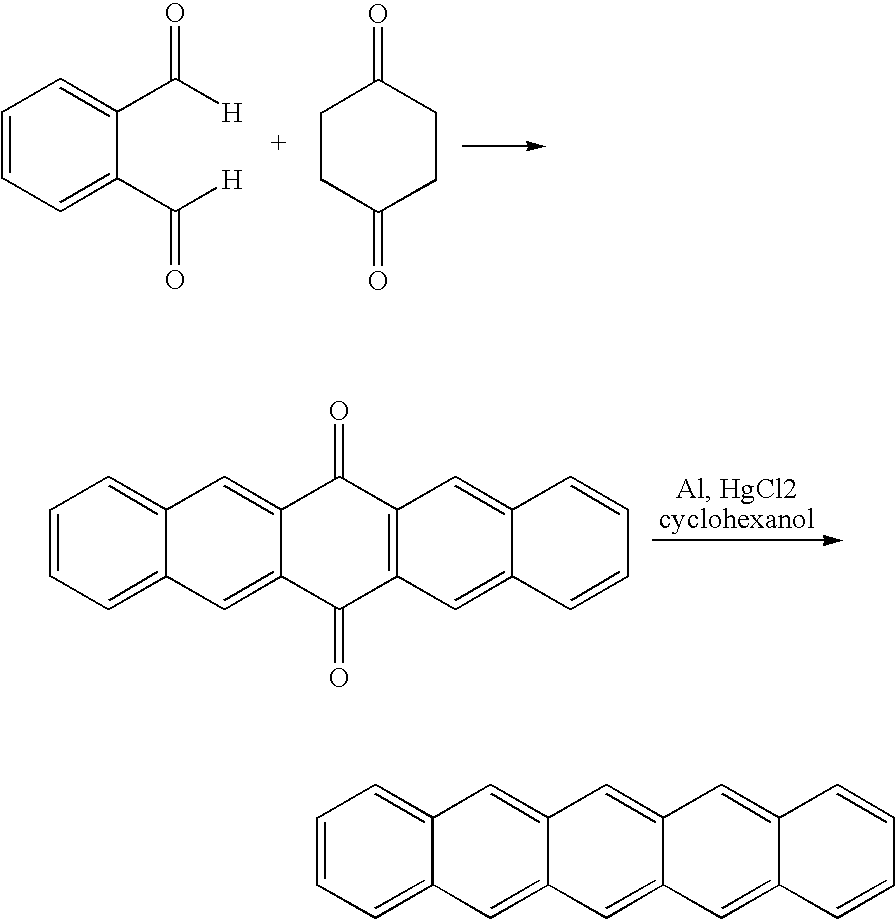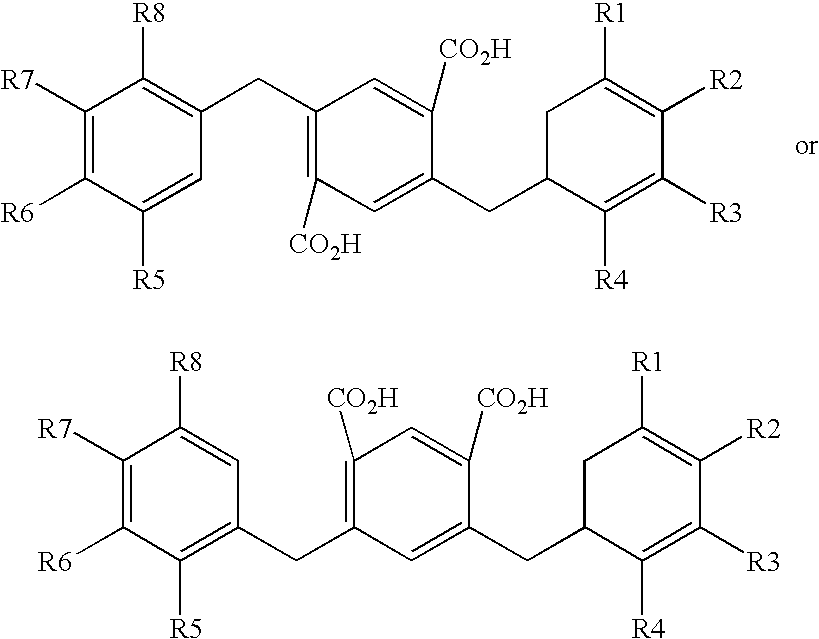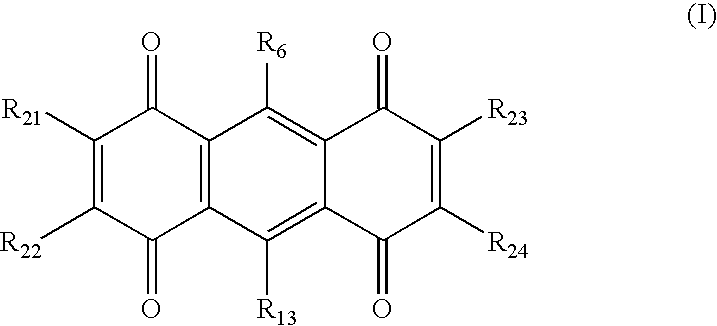Compounds comprising a linear series of five fused carbon rings, and preparation thereof
a technology of fused carbon rings and compounds, applied in the field of pentacene compounds, can solve the problems of preventing solution-based processing, requiring expensive equipment and long pump-down cycles, polymorphic nature, etc., and achieve optimal electronic properties and amenable to further manipulation
- Summary
- Abstract
- Description
- Claims
- Application Information
AI Technical Summary
Benefits of technology
Problems solved by technology
Method used
Image
Examples
example 1
Synthesis of 1,4,5,8-Anthradiquinone
[0335]Two lengthy synthetic routes (>5 steps) to the desired 1,4,5,8-anthradiquinone (3) starting material have been reported, but large amounts of high purity material could not be obtained.i An alternative two-step preparation of anthradiquinone 3 was reported by Cory's group (Scheme 3);ii however, the yields for each reaction were below 50%. 1,4,5,8-Anthradiquinone (3) was a key intermediate in our route to pentacene, thus an optimized preparation of 3 was desired.
[0336]
[0337]The first reaction that was attempted was the original procedure reported by Fitzgerald (Table 1, entry 1). A solution of lithium 2,2,6,6-tetramethylpiperidine (LTMP, 7) in THF was prepared by the addition of methyllithium to 2,2,6,6-tetramethylpiperidine (TMP). The LTMP solution was heated to reflux, bromide 1 was added, and heating was continued for one hour. The reaction was cooled to room temperature and poured into HCl (10% aq). A small amount (16% yield) of 1,4,5,8-t...
example 2
Synthesis of Silyl Ethers
[0345]With anthradiquinone 3 in hand we began studying the double Diels-Alder reaction and the inevitable separation of the resulting regioisomers. Danishefsky-type dienes readily undergo [4+2] cycloadditions with quinones and the reaction products are known to oxidize on silica gel in the presence of oxygen to the corresponding aromatic product (Scheme).v
[0346]
[0347]The first reaction that was conducted was a reaction of anthradiquinone 3 with Danishefsky's diene 14 (Scheme 6). After stirring the reaction overnight at room temperature all of anthradiquinone 3 was consumed, but the desired silyl ethers were not formed when the reaction was treated with silica gel. A proton NMR spectrum of the reaction product suggested that desilylation had occurred to give a mixture of 17 and 18 instead of elimination of methoxide and aromatization as desired.
[0348]
[0349]The double Diels-Alder reaction was repeated with a bulker t-butyldimethylsilyl Danishefsky's diene, 10,...
example 3
Preparation of Ditriflates
[0355]With the anticipated troublesome steps in our 2,9- and 2,10-disubstituted pentacene synthesis behind us, we turned our focus to the preparation of ditriflates 25 and 26. These key intermediates would allow a multitude of substituted pentacene derivatives to be prepared in order to study the effect of various functional groups on the electronics and solid-state packing of these compounds.
[0356]Treatment of a solution of silyl ether 22 in THF with TBAF at room temperature resulted in a deep blue solution that gave diol 24 as a pale yellow solid after the addition of water (Scheme). Diol 24 was recovered by filtration and was not soluble in organic solvents. In fact, diol 24 was only soluble in aqueous NaOH (10%), giving a deep blue solution. Diol 24 could not be characterized due to its poor solubility.
[0357]
[0358]Numerous attempts to convert diol 24 to ditriflate 25 were unsuccessful (Table 2). When diol 24 was suspended in methylene chloride and treat...
PUM
| Property | Measurement | Unit |
|---|---|---|
| sub-threshold voltages | aaaaa | aaaaa |
| dielectric constant | aaaaa | aaaaa |
| dielectric constant | aaaaa | aaaaa |
Abstract
Description
Claims
Application Information
 Login to View More
Login to View More - R&D
- Intellectual Property
- Life Sciences
- Materials
- Tech Scout
- Unparalleled Data Quality
- Higher Quality Content
- 60% Fewer Hallucinations
Browse by: Latest US Patents, China's latest patents, Technical Efficacy Thesaurus, Application Domain, Technology Topic, Popular Technical Reports.
© 2025 PatSnap. All rights reserved.Legal|Privacy policy|Modern Slavery Act Transparency Statement|Sitemap|About US| Contact US: help@patsnap.com



